By: Simon Brooke :: 14 July 2023
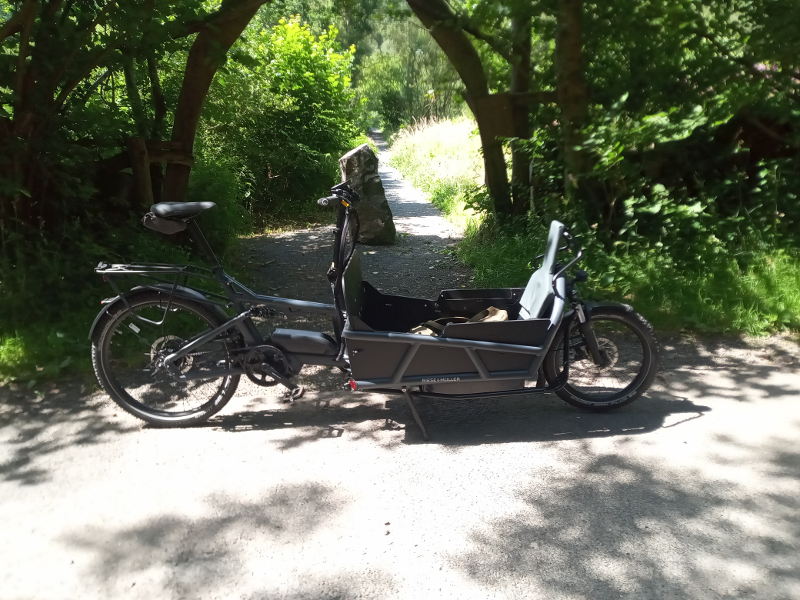
The Riese und Müller Load 4 75 is a very high end cargo bike; in my estimation, one of the best currently available. It's also fairly expensive, even for the base model; and when one adds all the desirable options the price really mounts up.
It's of the type known in the Netherlands, where the design is popular, as a bakfiets: that is to say the rider sits at the back, in the relationship with the rear wheel which they would have on a conventional bicycle; and the cargo box is in front of the handlebars. So where is the front wheel? Why, in front of the cargo box, which is quite a long way forward; so it's linked to the handlebars through a linkage.
The bicycle is rated for a maximum cargo of 67kg, and a maximum train weight (including the weigh of the bike itself and the rider) of 200 kg.
Our village bicycle hire scheme now has one — and I'll admit that's largely at my recommendation — and yesterday I took it out for its first significant run: to Castle Douglas, for groceries and farm supplies.
This post is therefore a combination of ride report and initial review.
Options
I'll start by going over the specification of our particular example — which is close to being at the top of the specification. It has
- A Rohloff Speedhub 14 speed gearbox, with electronic shifting;
- A Gates belt drive, developed in Dumfries (but sadly no longer made there);
- A Bosch Nyon Display;
- An extra 545 watt battery pack, making two in total;
- Three child seats, and an optional footwell extension (although I didn't take the rear seats with me on this journey);
- A rain hood to cover the load box (again, I did not take this);
- All-terrain tyres;
- An additional chain lock.
I note that an antilock braking system is an option; I'm not certain whether ours has that, but in any case it wasn't an issue on this trip.
It's also supplied with a headlight, a rear light attached to the (standard) rear luggage rack, and full mudguards.
This is designed to be a practical, utility, all-weather bike, not a fair weather toy. It's strong and sturdy and well designed. The bicycle and most of its accessories — all that I've mentioned except the belt drive — are of German design and German manufacture, with all that implies for both quality and cost.
Ergonomics
This is a very large bicycle. It's almost twice the length of a conventional bicycle, and considerably longer than a conventional tandem; it's also about 65cm wide (I'll measure, and update this). It's also heavy; 38kg in standard configuration. Despite this, its well balanced and wasn't hard to manoeuvre on foot when empty.
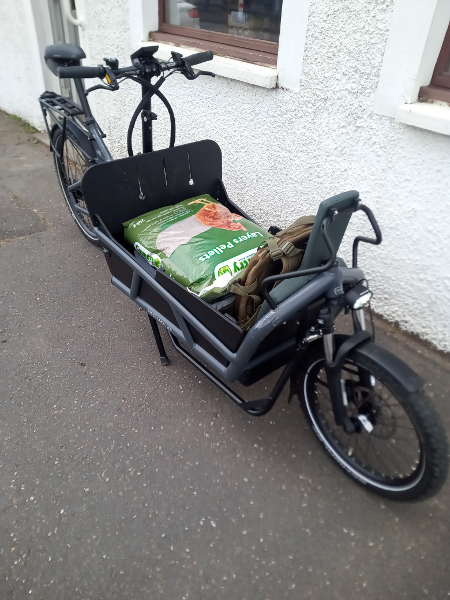
There's a folding stand under the cargo box; to deploy it you push it down with your foot, and then pull the bike backwards until it locks. To stow it, you push the bike forward off the stand, which should then just spring up; in practice I had once or twice to assist it with my foot. When on the stand on level ground the bike was very stable.
The riding position is very adaptable: the handlebars can easily be raised and lowered by a considerable amount, and, additionally, the upper part of the steerer tube to which the handlebars are mounted can be raked forward and back to adjust reach. The saddle also can be adjusted through a very considerable range of heights. So it's possible to quickly adjust the bike to riders of very different sizes.
Although adaptable, the riding position is very much 'sit up and beg'. This has the advantage that you have a really commanding view of the road ahead, and can also turn your head much more easily than you can in a more sporting crouch; both things which are valuable when you're riding quite so large a vehicle.
The handlebars are flat, and, although they have 'ergonomic' grips which do help a bit, I found I had some stiffness in my wrists after 38 kilometres of riding; I'd prefer it if they had bar ends, but they don't (again, if the bike were mine, I'd probably fit them). Finally, on a bike this size, although it was reasonably easy to look behind, a bar end mirror would be an accessory worth having.
The bike has suspension both front and rear: a conventional suspension fork forward and a pivoting rear triangle with a 'coil over' suspension unit at the back. I've no comment to make about the front suspension: it just worked. To my taste, the rear suspension was set up a little soft and a little underdamped; but it is adjustable, and, in discussion with those in charge of the hire scheme, we may get it tuned a little better. Having said that, when, through momentary inattention, I hit a pothole unexpectedly, the suspension system coped magnificently and the big bike sailed on unflustered.
The bottom bracket is quite high, a consequence of full suspension. This means that many riders will find it hard to get a foot on the ground while seated in the saddle, with the saddle adjusted for maximum biomechanical efficiency. So you might need to have the saddle lower than you'd ideally like, or, alternatively, make a habit of slipping off the saddle when coming to a halt. But there's no top tube, and the standover height is quite low, so slipping off the saddle and standing when coming to a halt will work for all riders.
There is no obvious mounting point for a bottle cage within reach of the saddle, although one could probably be attached to the outside of the rear of the cargo box.
For me, the one failing of the whole bike, the one negative note you're going to find in this review, is the saddle, which is large, very wide, and very heavily padded. This is probably fine if you're going to put the motor assist into its highest mode all the time, but it is much too wide for my pelvis and felt as if it were trying to wedge my thighs apart. If the bike were mine I would change the saddle, but it isn't so I will probably have to put up with it; but my suspicion is that it will be too wide for most people.
Riding: unloaded
Obviously, I headed out to town with no load. I live near the top of a 150 metre hill, so the start of every journey is a long, fast descent, and the end of every journey is a sturdy climb. The bike was immediately stable and tractable, although the very long front means that steering is not as agile as on a racing bike.
The electronic gear change for the Rohloff works easily, and the selected gear is shown on the display. What I barely noticed on the outbound journey but really appreciated on the return is that there's an interface between the gear change and the motor control system, which momentarily cuts power to the motor while the gear is changing. This is effectively like an automatic clutch on a car, and makes gear changes much smoother (although it still helps to ease up on pedalling while changing gear). Down the big hill I achieved a maximum speed of 53 km/h with some ease. The bike was docile and stable at this speed, and felt very safe.
I spent the whole outward journey in the 'eco' mode of the motor control, and averaged 18 km/h, with, according to the display unit, 64% of that input coming from my muscles, only 36% from the motor; this despite over 150 metres total ascent. The outward journey (17.5 km) consumed less than 5% of the battery.
Riding: loaded
Once into town, I went first to the farm suppliers, and picked up a 25 kg bag of cattle sweeties and a 20 kg bag of chicken feed. I then went to the vets to order some medicine for my cat, to the co-op for about 8kg of groceries, to the bike shop for a blether, and to the bakery for something for my lunch.
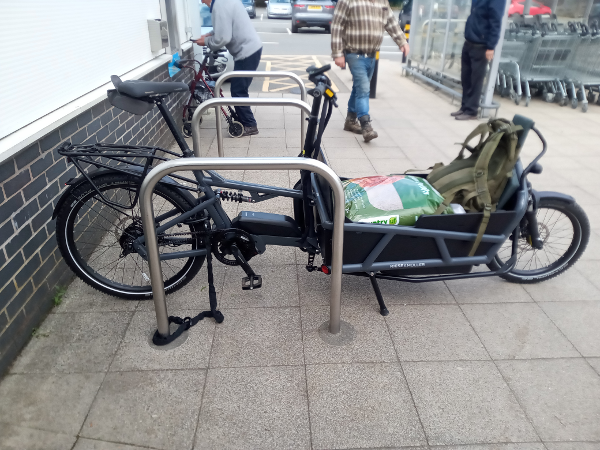
I went to the farm suppliers first because they were about to close for their lunch; but actually, making all the additional stops in town with a full load, and riding around the town in traffic with the full load, was useful experience. With 50kg in the load box the bicycle is a lot less easy to manoeuvre on foot, and once riding low speed steering takes getting used to: I found it helped to start off with the steering pointing straight forward, and not to attempt a turn until the bike was up to about 10 km/h. Fortunately, the Rohloff makes it extremely easy to change gears while stationary, and in low gear the bicycle accelerates well, even without motor assist; and you do have motor assist.
I navigated all the junctions and the roundabout I needed to negotiate without difficulty, although I'll admit with some nervousness at first.
Getting the bike on and off the stand fully loaded was not difficult. Manoeuvering on foot took care and attention. Once the bike is leaning to any degree, it takes a rather surprising amount of strength to get it back upright. Obviously the trick here is to keep it upright!
It's worth saying a word of praise here for the built in locking system. This is an Abus lock of the style that used to be called a 'nurse's lock'; that is to say, permanently mounted to the rear triangle of the bike, with a bar which, when locked, goes through the spokes, preventing the wheel rotating. This isn't a very secure sort of lock, in general; the entire bicycle could be lifted (although this one is not an easy lift) into a van and driven away to some quiet place where the lock could be cut. But this one has an added (optional) feature: a sturdy chain which stows in a bag under the saddle, and a socket in the lock into which the end of the chain can be pushed. This makes it very easy to lock the bike to a bicycle stand, road sign, lamp post, or other item of secure street furniture. The same key that operates this lock also locks the two batteries in their places. This is a proper, ruthlessly efficient, German approach to bicycle security.
On the journey home, loaded, I found that the bicycle felt comfortably stable above about 15 km/h and manageable above 10 km/h, but I was nervous about letting it get below that speed. Consequently, I made full use of the motor on the hills. I felt, in particular, that having to make a hill start might be quite difficult, so I very much wanted to avoid stopping on the steeper hills (and this was where the 'automatic clutch' function of the electronic gear shifter was particularly appreciated).
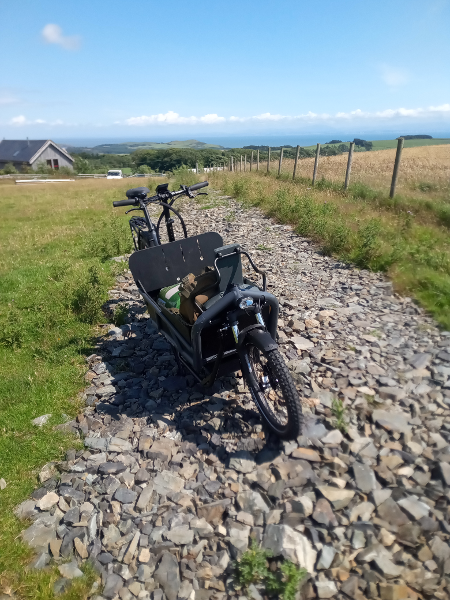
However the motor has plenty of power, and maintaining speed up 15% gradients was not a problem (although I'll admit I used the 'turbo' setting for those bits!).
Apart from junctions, where I remained nervous, I found the bicycle, overall, very comfortable and confidence inspiring to ride. As I've mentioned before I found the suspension a little soft, and this was exacerbated by the load; it wallowed a little over some bumps. The saddle gradually became actively painful, and I would have appreciated being able to vary hand positions. But these are minor things, and all could be fixed.
Arriving home, I rode up the very steep, rocky, unsurfaced track over the top of the hill to my own croft. It was absurd to ask this big bike with its heavy load to manage a track that is passable by car only in excellent conditions. And yet it did it with confidence and without trouble.
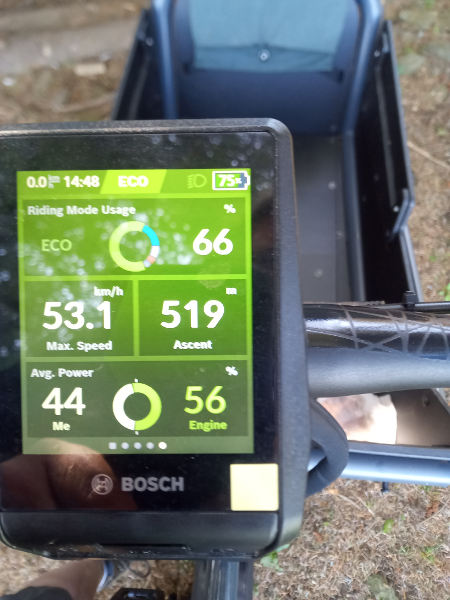
So, overall, 38km, 519 metres total ascent, average speed 17.5 km/h, max speed 53km/h; 25kg cattle bribes, 20kg chicken feed, about 8kg groceries, total cargo about 53kg. Exactly 25% of the of the battery was used. Over the whole trip, I used 'eco' mode 66% of the time, 'tour' mode 15%, 'sport' mode 8%, 'turbo' mode about 4% (two very steep hills), and motor off the rest. The display computed that over the whole trip my muscles supplied 44% of the power while the motor supplied the other 56%.
Conclusions
I was expecting a lot of this bike, and overall, on this first outing, it exceeded expectations. Apart from that saddle (and of course saddles are very personal) it was comfortable to ride, and its handling, except at low speeds when heavily loaded, was footsure and confidence inspiring.
It is, of course, large, heavy and valuable. If you buy one, you will need somewhere secure to keep it, and it needs to be somewhere you can wheel it on the flat — it's possible to lift it, unloaded, but you certainly wouldn't want to carry it up even a short flight of stairs. The motor has a walk assist function which should help with ramps.
After I got home I experimented a little with pushing it with different loads. Up to about 35 kg of cargo it felt reasonably tractable, but above that it began to feel really unwieldy.
With cargo loaded, the worst than can happen if the bike falls over while you're manoeuvering on foot is that you spill your cargo and look a prat, but children are another matter. Thirty five kg is two average four year olds; the load box has room for three child seats but I think three four-year-olds might be a little anxiety inducing. I wouldn't have much anxiety about the bike falling over while you're riding; it's very stable once it's properly moving.
I also wouldn't have anxiety about the braking system. The bike has hydraulic disk brakes, with larger rotors than on a standard road bike. I weigh 71 kg, the bike 38, my load was 53, total 162 kg or thereabouts; I came down some pretty steep hills, and braking was always assured.
The bottom gear on the Rohloff is pretty low. I think that, if you ran out of battery, the limitation on getting up hills even when loaded would be stability rather than strength. Nonetheless I wouldn't like to run out of battery on this thing, certainly not in here in Galloway!
Repairing a tyre at the roadside would also be something of a job. The bike was supplied with an all-terrain variant of Schwalbe Marathon tyres, which are extremely resistant to punctures; and that is of course a good thing. But punctures still happen.
I live 17 km from the nearest town, at the top of a very big hill. I've experimentally brought a full bottle of butane gas — total weight 38 kg — home in a bicycle trailer before, and it was a very unpleasant and rather unsafe experience because I found the trailer began to dynamically oscillate on downhills, especially when braking. To stop using a car (and I have given up my car) I need to be able to bring home heavy items, such as gas bottles, but also some farm supplies.
When I was considering buying one of these for myself — and before the cycle hire scheme decided to buy one I was seriously considering buying one, although it would have meant borrowing — that 38 kg gas bottle was the target it had to be able to carry. I'm now confident it can, and more. It can't, for me, replace all the things I could use a car for — for example, I could not use it to take a sick or injured adult to hospital, or to go up and visit my sister in Edinburgh and return the same day. So it is not a total car raplacement. But neither of these are things I ever did very often (sorry, Polly!)
I think an electric cargo bike (or a conventional bike with occasional use of an electric cargo bike, which is what I now have) is an effective replacement for 95% of the uses I will ever have for a car, and I think that for very many people it will be an effective replacement for 95% of the uses they will ever have for a car. I think that, in particular, having a shared cargo bike as a community resource, as we now have here, will help many people to curtail their car use, and save many car journeys.
So I'd recommend both the principle of a communally owned cargo bike, and this particular model.




